Sedum
| Sedum | ||||||||||||
|---|---|---|---|---|---|---|---|---|---|---|---|---|
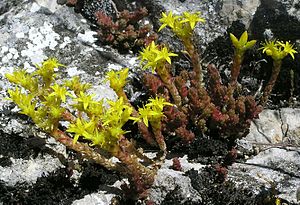
Spicy stonecrop ( Sedum acre ) |
||||||||||||
| Systematics | ||||||||||||
|
||||||||||||
| Scientific name | ||||||||||||
| Sedum | ||||||||||||
| L. |
Sedum is a genus of plants fromthe thick-leaf family (Crassulaceae). With around 420 species, it is the most extensive genus in this family. German common names are stonecrop and fatty hens .
description

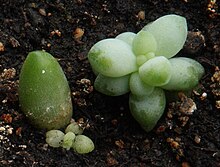

Vegetative characteristics
Sedum species are annual or perennial herbaceous plants , more rarely sub-shrubs that are more or less succulent . There are mostly fiber roots. Most of the time there is no “rhizome” and a few species have a rhizome . The often fleshy stems are usually upright or prostrate, sometimes they are in clusters or moss-like together; their base is seldom lignified. The above-ground parts of the plant are mostly bare, much less often hairy.
The thick-fleshed leaves in particular store water. The leaves are alternate, opposite or whorled. The leaf margins are mostly smooth (for example, in Sedum rosthornianum four to eight teeth or in Sedum engleri var. Dentatum, remotely serrated). Stipules are missing.
Generative characteristics
The inflorescences are structured differently. The mostly hermaphrodite, rarely unisexual flowers are usually five-fold, rarely three to nine-fold. The sepals are usually free or less often fused at the base. The mostly five predominantly yellow, more rarely white or reddish petals are mostly free or almost free. There are usually two circles with usually five stamens each. The carpels are free or fused at their base.
There are follicles formed. The seeds are small.
physiology
Most of the species in the Sedum genus are CAM plants .
Systematics and distribution
The genus Sedum is mainly found in the subtropical and temperate zones of the northern hemisphere . However, some species are native to Central and East Africa, as well as South America . The greatest biodiversity is found in North America (around 170 species), followed by Asia (around 130 to 140 species). The remaining one hundred or so species are distributed across Europe, the Middle East, Africa and the Atlantic Islands.
The genus Sedum was first published in 1753 by Carl von Linné in Species Plantarum . The botanical name of the genus Sedum is derived from a Latin common name for several species of the thick-leaf family. Type species is Sedum acre L. Linné published 16 species in Species Plantarum . Synonyms for Sedum L. are: Aithales Webb & Berthel. , Aizopsis Grulich , Amerosedum Á.Löve & D.Löve , Anacampseros Mill. , Asterosedum Grulich , Breitenia Á.Löve & D.Löve , Cepaea Fabr. , Chetyson Raf. , Clausenellia Á.Löve & D.Löve , Cockerellia (RTClausen & NWUhl) Á.Löve & D.Löve , Congdonia Jeps. , Corynephyllum Rose , Etiosedum Á.Löve & D.Löve , Gormania Britton , Helladia M.Král , Hjaltalinia Á.Löve & D.Löve , Keratolepis Rose ex Fröd. , Leucosedum Fourr. , Macrosepalum Regel & Schmalh. , Mucizonia (DC.) Batt. & Trot. , Oreosedum Grulich , Parvisedum R.T. Clausen , Petrosedum Grulich , Poenosedum Holub , Procrassula Griseb. , Pseudorosularia Gurgen. , Sedastrum Rose , Sedella Fourr. nom. inval., Spathulata (Boriss.) Á.Löve & D.Löve , Telmissa Fenzl , Tetrorum Rose , Triactina Hook. f. & Thomson . The genus Sedum is paraphyletic to this extent .
The genus Sedum belongs to the subtribe Sedinae from the tribe Sedeae in the subfamily Sedoideae within the family Crassulaceae .
According to Henk 't Hart (1944–2000) and Bert Bleij, the genus Sedum is subdivided into two sub-genera with the following species;










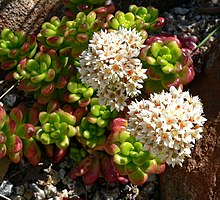
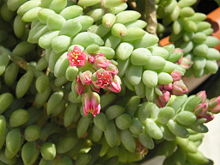



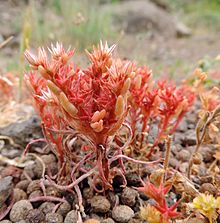

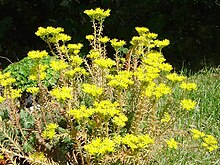


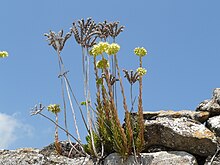
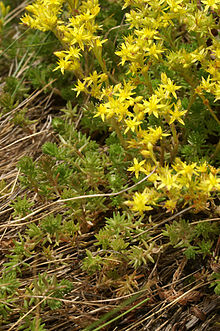


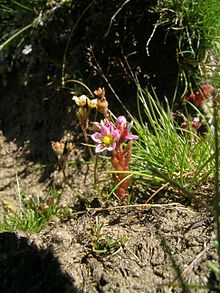









- Subgenus Sedum
- Sedum abchasicum Kolak. ex VVByalt
- Hot stonecrop ( Sedum acre L. )
- Sedum acropetalum Fröd.
- Sedum actinocarpum Yamam. : It occurs only in Taiwan at altitudes of 300 to 2500 meters.
- Sedum adolphii Raym.-Hamet : It is common in Mexico.
- Sedum aetnense Tineo : It occurs in southern Europe .
- Sedum alamosanum S. Watson : It occurs in northwestern Mexico.
- Sedum albertii rule
- White sedum plant ( Sedum album L. )
- Sedum alexanderi Eggli
- Sedum alfredii Hance : It occurs in Japan, Korea and China.
- Sedum allantoides rose : It is common in Mexico.
- Alpine sedum ( Sedum alpestre Vill. )
- Mierenblättriger Stonecrop ( Sedum alsinefolium All. ): This endemic thrives only in the Italian western Alps .
- Sedum × amecamecanum Praeger
- Sedum andegavense (DC.) Desv. : It is spread from Algeria and Morocco via Spain and Portugal via France , Corsica , Sardinia to Italy .
- Sedum andinum ball
-
English sedum plant ( Sedum anglicum Huds. ), Native to: Western Europe, Scandinavia
- Sedum anglicum subsp. anglicum
- Sedum anglicum subsp. pyrenaicum (Lange) Laínz : It occurs only in Portugal , northern Spain and southern France .
- Sedum angustifolium E.g. Hu & XLHuang
- Sedum anhuiense S.H.Fu & XWWang
- Annual sedum plant ( Sedum annuum L. )
- Sedum aoikon Ulbr.
- Sedum apoleipon 't Hart : It occurs in Greece.
- Sedum arenarium bread. ; Home: Portugal and Spain
- Dark stonecrop ( Sedum atratum L. )
- Sedum australe rose
- Sedum aytacianum J. Metzg.
- Sedum baileyi Praeger : It occurs in the Chinese provinces of Guangdong , Guangxi , Hunan and Jiangxi .
- Sedum balfourii Raym.-Hamet
- Sedum barbeyi Raymond-Hamet : It occurs in the Chinese provinces of Henan , Hubei and Shaanxi .
- Sedum batallae Barocio
- Sedum batesii Hemsl.
- Sedum × battandieri Maire
- Sedum beauverdii Raymond-Hamet : It occurs in the Chinese provinces of western Sichuan and northwestern Yunnan at altitudes of 3000 to 4000 meters.
- Sedum bellum Rose ex Praeger : It is common in Mexico.
- Sedum bergeri Raymond-Hamet : It occurs in eastern Yunnan at altitudes between 300 and 3500 meters.
- Sedum berillonianum Raymond-Hamet
- Sedum blepharophvllum Fröd. : It occurs in western Sichuan at altitudes from 3200 to 3800 meters.
- Sedum bonnieri Raymond-Hamet : It occurs in southern Shaanxi and eastern Sichuan.
- Sedum botteri Hemsl.
- Sedum bourgaei Hemsl.
- Sedum bracteatum Viv. ; Home: Libya
- Sedum brevifolium DC. : It is distributed from Morocco through Spain, Portugal to France, Corsica and Sardinia.
- Sedum brissemoretii Raymond-Hamet
- Sedum bulbiferum Makino : It is found in Japan, Korea and China.
- Sedum burrito Moran : The home is probably the Mexican state of Veracruz.
- Sedum caducum R.T. Clausen
- Sedum caeruleum L. , homeland: It occurs in Corsica , Sardinia , Malta and Sicily and in Tunisia, Algeria and Morocco.
- Sedum caespitosum (Cav.) DC. ; Home: Southern Europe, Western Asia, North Africa
- Sedum calcaratum rose
- Sedum calcicola B.L. Rob. & Greenm.
- Sedum candollei Boreau
- Sedum caroli-henrici Kit Tan ; Home: Asia Minor
- Sedum catorce G.L. Nesom
- Sedum celatum Fröd. : It occurs in southern Gansu and eastern Qinghai at altitudes of 2900 to 4200 meters.
- Sedum celiae Raymond-Hamet : It occurs in southwest Sichuan and northwest Yunnan at altitudes of 2600 to 3000 meters.
- Panicles stonecrop ( Sedum cepaea L. ): It is used in Europe, Middle East and North Africa.
- Sedum chauveaudii Raymond-Hamet : It occurs in two varieties in Nepal and in China.
- Sedum chihuahuense S. Watson
- Sedum chingtungense K.T.Fu : It occurs in western and central Yunnan at altitudes of around 2100 meters.
- Sedum chloropetalum R.T. Clausen
- Sedum chrysicaulum J.A. McDonald
- Sedum chuhsingense K.T.Fu : It occurs in central Yunnan.
- Sedum cilicicum Kit Tan & Vural ; Home: Asia Minor
- Sedum clausenii V.V.Byalt
- Sedum clavatum R.T. Clausen
- Sedum clavifolium Rose
- Sedum cockerellii Britton : It occurs in the US states of Arizona, New Mexico, California, Texas and in the Mexican states of Sonora and Chihuahua.
- Sedum commixtum Moran & Hutchison
- Sedum compactum Rose : It is common in Mexico.
- Sedum compressum rose : It occurs in the Mexican state of Tamaulipas.
- Sedum concarpum Fröd. : It occurs in southwest Hubei and southwest Yunnan at altitudes of 2800 to 3400 meters.
- Sedum confertiflorum Boiss. ; Home: Asia Minor, Aegean Sea and Greece
- Sedum confusum Hemsl.
- Sedum conzattii Rose : It occurs in the Mexican state of Oaxaca.
- Sedum copalense Kimnach
- Sedum cormiferum R.T. Clausen
- Sedum corymbosum Grossh.
- Sedum corynephyllum Fröd.
- Sedum craigii R.T. Clausen : It is common in Mexico.
-
Sedum creticum C. Presl ; Home: Crete and Karpathos
- Sedum creticum var. Creticum
- Sedum creticum var. Monocarpicum 't Hart
- Sedum cupressoides Hemsl. : It is common in Mexico.
- Sedum cuspidatum Alexander
- Sedum cymatopetalum Fröd.
- Sedum cyprium A.K. Jackson & Turrill : It occurs only in Cyprus.
- Sedum cyrenaicum Brullo & Furnari ; Home: Libya
-
Sedum daigremontianum Raymond-Hamet : It occurs in southern Gansu and Sichuan at altitudes of 2300 to 4000 meters. With the varieties:
- Sedum daigremontianum Raymond-Hamet var. Daigremontianum
- Sedum daigremontianum var. Macrosepalum Fröd.
- Sedum decipiens
-
Shrubby sedum ( Sedum dendroideum Moc. & Sessé ex DC. ): It is widespread from Mexico to Guatemala and is feral in northern France .
- Sedum dendroideum Moc. & Sessé ex DC. subsp. dendroideum
- Sedum dendroideum subsp. monticola (Brandegee) RTClausen
- Sedum dendroideum subsp. parvifolium R.T. Clausen
- Sedum dendroideum subsp. praealtum (A.DC.) RTClausen (Syn .: Sedum praealtum A.DC. ): It is naturalized in places in the Mediterranean.
- Sedum didymocalyx Fröd. : It occurs in western Sichuan at altitudes of 4400 to 4700 meters.
- Sedum dielsii Raymond-Hamet : It occurs in the Chinese provinces of Gansu, Hubei and Sichuan.
- Sedum diffusum S. Watson : It occurs in the Mexican states of San Luis Potosí , Nuevo León and Hidalgo.
- Sedum diminutum (RTClausen) GLNesom
- Sedum dimorphophyllum K.T.Fu & GYRao : It only thrives at altitudes of 2800 to 2900 meters in western Sichuan.
- Sedum dispermum Fröd.
- Sedum dolosum K.T.Fu
- Sedum dongzhiense D.Q.Wang & YLShi : It occurs in southern Anhui .
- Sedum dugueyi Raymond-Hamet : It thrives at altitudes of 2000 to 3600 meters in northwest Sichuan and northwest Yunnan.
- Sedum dulcinomen G.L.Nesom
- Sedum duthiei Fröd.
-
Sedum ebracteatum Moc. & Sessé : The two subspecies occur in Mexico.
- Sedum ebracteatum Moc. & Sessé subsp. ebracteatum
- Sedum ebracteatum subsp. grandifolium R.T. Clausen
- Sedum ecalcaratum H.J.Wang & PSHsu
- Sedum edwardsii (RTClausen) BLTurner
- Sedum elburzense Akhani & Assadi
- Sedum emarginatum Migo : It occurs in China at altitudes between 600 and 1800 meters.
- Sedum engleri Raymond-Hamet : It occurs in two varieties in southwestern Hubei, southwestern Sichuan and northwestern Yunnan at altitudes from 1900 to 3600 meters.
-
Sedum erici-magnusii Fröd. : There are two subspecies:
- Sedum erici-magnusii subsp. chilianense K.T.Fu : It occurs in western Gansu.
- Sedum erici-magnusii subsp. erici-magnusii (Syn .: Sedum erici-magnusii var. subalpinum Fröd. ): It occurs in western Sichuan and eastern Tibet at altitudes of 3800 to 4900 meters.
-
Sedum erythrospermum Hayata : There are about two subspecies:
- Sedum erythrospermum subsp. australe (Merr.) H.Ohba : It occurs in the Philippines.
- Sedum erythrospermum Hayata subsp. erythrospermum : It only thrives in Taiwan at altitudes of 2000 to 3500 meters.
- Sedum euxinum 't Hart & Alpinar : It occurs in Turkey.
- Sedum farinosum rose
- Sedum feddei Raymond-Hamet : It occurs in western Sichuan.
- Sedum fedtschenkoi Raymond-Hamet : It occurs in southern Qinghai, western Sichuan and eastern Xizang at altitudes from 3300 to 4800 meters above sea level.
- Sedum fischeri Raymond-Hamet : It occurs in northwestern India, in Bhutan, Sikkim and in Qinghai at altitudes between 3600 and 5600 meters.
- Sedum flaccidum rose
- Sedum formosanum N.E. Brown : It occurs on the coasts of Japan, the Philippines and Taiwan.
- Sedum forreri Greene
- Sedum forrestii Raymond-Hamet : It occurs in northwestern Yunnan at altitudes of 3400 to 4400 meters.
- Petite sedum ( Sedum forsterianum Sm. , Subsp as subspecies. Forsterianum (Sm) RLEvans. To rupestre Sedum L. provided)
- Fragrant stonecrop ( Sedum fragrans ' t Hart ): This endemic to the western Alps occurs in France and Italy.
- Sedum franchetii Grande : It occurs in northwestern Yunnan at altitudes of 2800 to 4100 meters.
- Sedum frutescens rose
-
Sedum fui Rowley : There are two varieties:
- Sedum fui var. Fui : It occurs in southern Sichuan and western Yunnan at altitudes of 3700 to 3800 meters.
- Sedum fui var. Longisepalum (KTFu) SHFu : This endemic occurs in northwestern Yunnan at altitudes of around 3500 meters.
- Sedum furfuraceum Moran
- Sedum fuscum Hemsl.
- Sedum fusiform lion
- Sedum gagei Raymond-Hamet : It occurs in Nepal, Bhutan, Sikkim and in southern Tibet .
- Sedum goldmanii (Rose) Moran
- Sedum grammophyllum Fröderström : It occurs in the Chinese provinces of Guangdong and Guangxi.
- Sedum grandisepalum R.T. Clausen
- Sedum grandyi Raym.-Hamet
- Sedum greggii Hemsl. : It is common in Mexico.
- Sedum griffithsii rose
-
Sedum grisebachii Boiss. & Hero. : The two varieties occur on the Balkan Peninsula, Romania:
- Sedum grisebachii var. Grisebachii
- Sedum grisebachii var. Horakii (Rohlena) froed.
- Sedum griseum Praeger : It is common in Mexico.
- Sedum guadalajaranum S. Watson
- Sedum guatemalense Hemsl.
- Sedum gypsicola Boiss. & Reut. , Home: Spain, Tunisia, Algeria, Morocco
- Sedum gypsophilum B.L. Gymnast
- Sedum hakonense Makino : It occurs in Japan and in northern Guangdong .
- Sedum hangzhouense K.T.Fu & GYRao : It occurs in northern Zhejiang .
- Sedum heckelii Raymond-Hamet : It occurs in western Sichuan and eastern Tibet at altitudes of 3500 to 4200 meters.
- Sedum hemsleyanum Rose : It is common in Mexico.
- Sedum hengduanense K.T.Fu : It occurs in southwest Sichuan, southeast Xizang and northwest Yunnan at altitudes of 2100 to 2900 meters.
- Sedum henrici-robertii Raymond-Hamet : It occurs in Nepal, in eastern Qinghai, in southern Tibet and perhaps also in Bhutan and Sikkim.
- Sedum hernandezii J. Meyrán
- Sedum hintonii R.T. Clausen
- Sedum hintoniorum B.L. Turner
-
Felty sedum plant or hairy stonecrop ( Sedum hirsutum All. ): The two subspecies occur in southern Europe and Morocco:
- Sedum hirsutum subsp. baeticum Rouy
- Sedum hirsutum subsp. hirsutum
- Spanish stonecrop or Spanish stonecrop ( Sedum hispanicum L. ); Home: Europe, Middle East
- Sedum holei Raym.-Hamet
- Sedum holopetalum Fröd.
- Sedum hultenii Fröd. : It is common in Mexico.
- Sedum humifusum rose : It is common in Mexico.
- Sedum jahandiezii Batt. ; Home: Morocco
- Sedum jaliscanum S. Watson
- Sedum jiaodongense Y.M.Zhang & XDChen
- Sedum jinianum X.H.Guo
- Sedum jiuhuashanense P.S. Hsu & HJWang
- Sedum jiulungshanense Y.C.Ho : It occurs in western Zhejiang .
- Sedum jujuyense Zardini
-
Sedum jurgensenii (Hemsl.) Moran
- Sedum jurgensenii subsp. attenuatum Moran
- Sedum jurgensenii subsp. jurgensenii
- Sedum kiangnanense D.Q.Wang & ZFWu : It occurs in southern Anhui at altitudes of 200 to 800 meters.
- Sedum kimnachii V.V. Byalt
- Sedum kingdonii H.Ohba
-
Sedum laconicum Boiss. & Hero.
- Sedum laconicum subsp. laconicum ; Home: Balkan Peninsula, Crete
- Sedum laconicum subsp. pallidum 't Hart & van Ham ; Home: Middle East
- Sedum laconicum subsp. pentapolitanum Brullo & Furnari ; Home: Libya
- Sedum lagascae Pau ; Home: Spain
- Sedum lampusae (Kotschy) Boiss. : This endemic occurs only in Cyprus.
-
Sedum lanceolatum Torr. : It occurs in Canada and the United States. With the subspecies:
- Sedum lanceolatum subsp. lanceolatum
- Sedum lanceolatum subsp. nesioticum (GNJones) RTClausen
- Sedum lanceolatum subsp. subalpinum (Blankinship) RTClausen
- Sedum lancerottense R.P. Murray
- Sedum latentibulbosum K.T.Fu & GYRao : It occurs in northern Jiangxi at altitudes of 800 to 900 meters.
- Sedum latifilamentum R.T. Clausen
- Sedum leblanciae Raymond-Hamet : It occurs in southwestern Sichuan and northwestern Yunnan at altitudes between 1500 and 3500 meters.
- Sedum leibergii Britton : It occurs in Washington, Oregon and Idaho.
- Sedum lenkoranicum Grossh.
- Sedum lenophylloides rose
- Sedum leptophyllum Fröd. : It occurs in the Chinese provinces of Anhui, Hubei, Hunan and Zhejiang.
- Sedum leucocarpum Franchet : It occurs in southwestern Sichuan and northwestern Yunnan at altitudes from 1600 to 2800 meters.
- Sedum liebmannianum Hemsl. : It is common in Mexico.
- Sedum linear Thunb. : It occurs on the Japanese Ryūkyū Islands , also in China.
-
Sedum litoreum cast. ; Home: Southern Europe, Western Asia, Libya
- Sedum litoreum var. Creticum 't Hart
- Sedum litoreum var. Litoreum
- Sedum longifuniculatum K.T.Fu : It occurs in Sichuan at an altitude of about 4200 meters.
-
Sedum longipes rose
- Sedum longipes subsp. longipes
- Sedum longipes subsp. rosular R.T. Clausen
- Sedum longyanense K.T.Fu : It occurs in eastern Tibet .
-
Sedum × Lorenzoi 't Hart
- Sedum × lorenzoi nothosubsp. hommelsii
- Sedum × lorenzoi nothosubsp. lorenzoi
- Sedum luchuanicum K.T.Fu : It occurs in Yunnan at altitudes of around 4400 meters.
- Sedum lucidum R.T. Clausen
- Sedum lumholtzii B.L. Rob. & Fernald
- Sedum lungtsuanense S.H.Fu : It occurs in Fujian and Zhejiang provinces.
-
Sedum × luteolum
- Sedum × luteolum nothosubsp. hegnaueri
- Sedum × luteolum nothosubsp. luteolum
- Sedum luteoviride R.T. Clausen
-
Sedum lutzii Raymond-Hamet : There are two varieties:
- Sedum lutzii var. Lutzii : It occurs in western Sichuan at altitudes of around 4400 meters.
- Sedum lutzii var. Viridiflavum K.T.Fu : It occurs in western Sichuan at altitudes of 4200 to 4300 meters.
- Sedum macdonaldii G.L. Nesom
- Sedum macdougallii Moran
- Sedum madrense S. Watson
- Sedum magellense Ten. ; Home: Italy, Balkan Peninsula, Aegean Sea, Asia Minor, Algeria
- Sedum magniflorum K.T.Fu : It occurs at altitudes of around 3800 meters only in northwestern Yunnan.
- Sedum maireanum Sennen ; Home: Spain and Portugal
- Sedum majus (Hemsley) Migo : It occurs in Nepal, Bhutan, Sikkim and in China.
- Sedum makinoi Maximowicz : It occurs in Japan and the Chinese provinces of Anhui and Zhejiang .
- Sedum maurum Humbert & Maire ; Home: Morocco
- Sedum melanantherum DC. : It occurs only in southern Spain .
- Sedum mellitulum rose
- Sedum mexicanum Britton : The home is Mexico and it is a neophyte in Spain, France and Corsica, in Asia, North and South America.
- Sedum meyeri-johannis Engl.
- Sedum meyranianum J. Metzg.
- Sedum microsepalum Hayata : It occurs only in Taiwan at altitudes of 1700 to 3000 meters.
- Sedum microstachyum (Kotschy) Boiss. : This endemic occurs only in Cyprus.
- Sedum millspaughii Raym.-Hamet
-
Sedum minimum Nieuwl.
- Sedum minimum subsp. delicatum (Rose) RTClausen
- Sedum minimum subsp. minimum
- Sedum mocinianum Pérez-Calix
- Mondovi stonecrop ( Sedum monregalense Balb. ), Native to: Corsica, southern France, Italy
-
Mountain Stonecrop or Mountain Stonecrop ( Sedum montanum Perr. & Songeon )
- Sedum montanum subsp. montanum , home: Central and Southern Europe
- Sedum montanum subsp. orientale 't hard ; Home: Europe
-
Sedum moranense Kunth : It is common in Mexico. With the subspecies:
- Sedum moranense subsp. grandiflorum R.T. Clausen
- Sedum moranense subsp. moranense
- Snake sedum plant ( Sedum morganianum E. Walther ): The home is the Mexican state of Veracruz.
- Sedum morrisonense Hayata : It occurs only in Taiwan at altitudes between 2500 and 3900 meters.
- Sedum mucizonia (Ortega) Hamet ; occurs in Spain and Portugal
-
Sedum multicaule Wallich ex Lindley : There are two subspecies:
- Sedum multicaule subsp. multicaule : It occurs in Bhutan, India, Myanmar, Nepal, Pakistan, Sikkim and in China.
- Sedum multicaule subsp. rugosum K.T.Fu : It occurs in northwestern Yunnan and southeastern Tibet at altitudes of 2200 to 2300 meters.
- Sedum multiceps Coss. & Durieu ; Home: Algeria, naturalized in Corsica
- Sedum multiflorum R.T. Clausen
- Sedum muscoideum rose
- Sedum muyaicum K.T.Fu : It occurs in western Sichuan.
- Sedum nagasakianum H.Ohba
- Sedum nanchuanense K.T.Fu & GYRao : It occurs in southeast Sichuan.
- Sedum nanifolium Fröderström : It occurs in Texas and Mexico at altitudes between 1300 and 2000 meters above sea level.
- Sedum nanum Boiss. ; occurs in Asia Minor
- Sedum napiferum Peyr. : It occurs in Mexico.
- Sedum neovolcanicum Pérez-Calix & I. García
- Sedum nevadense Cosson ; Home: Spain
- Sedum niveum Davidson : It occurs in California and Baja California at altitudes of 1500 to 3000 meters.
- Sedum nokoense Yamamoto : It occurs only in Taiwan at altitudes between 2500 and 3900 meters.
- Sedum nothodugueyi K.T.Fu : It occurs in western Sichuan at about 2300 meters.
- Sedum nudum Aiton
- Sedum nussbaumerianum Bitter : It is common in Mexico.
- Sedum nuttallii Torr. & E. James ex Eaton : It occurs in the US states of Kansas, Oklahoma, Missouri, Texas, Arkansas and Louisiana.
- Sedum oaxacanum Rose : It is common in Mexico.
- Sedum obcordatum R.T. Clausen : It is common in Mexico.
- Sedum oblanceolatum R.T. Clausen : It occurs in Oregon and California.
- Sedum obtrullatum K.T.Fu : It occurs in southeastern Tibet and northwestern Yunnan at altitudes of 2400 to 3300 meters.
-
Sedum obtusipetalum Franchet : It occurs in Nepal and in southwestern Sichuan and in northwestern Yunnan at altitudes from 2000 to 3700 meters. With the subspecies:
- Sedum obtusipetalum subsp. dandyanum H.Ohba
- Sedum obtusipetalum Franchet subsp. obtusipetalum
- Yellow ocher stonecrop ( Sedum ochroleucum Chaix )
- Sedum ocuilense J. Meyrán
- Sedum oligocarpum Fröd. : It occurs in western Sichuan at altitudes of 4400 to 4600 meters.
-
Sedum oligospermum Maire : It occurs in Myanmar and China.
- Sedum oligospermum var. Emarginatum (SHFu) VVByalt
- Sedum oligospermum var. Oligospermum
- Sedum onychopetalum Fröd. : It occurs in Anhui, Jiangsu and Zhejiang.
- Sedum orbatum Moran & J.Meyrán
- Sedum oreades (Decaisne) Raymond-Hamet : It occurs in Bhutan, India, Myanmar, Pakistan, Sikkim, in Yunnan and Tibet.
- Sedum oteroi Moran
- Sedum oxycoccoides rose
- Sedum oxypetalum Kunth : It is common in Mexico.
- Sedum pachyphyllum Rose : It occurs in the Mexican state of Oaxaca.
- Sedum pagetodes Fröd. : It occurs in southern Qinghai and western Sichuan at altitudes between 3700 and 4600 meters.
- Sedum pallidum M.Bieb. , occurs on the Balkan Peninsula and in Western Asia
- Sedum palmeri S. Watson : It is common in Mexico.
- Sedum pampaninii Raymond-Hamet : It occurs in Henan, Shaanxi, Sichuan and Yunnan.
- Sedum papillicaulum G.L.Nesom
-
Sedum parvisepalum Yamamoto
- Sedum parvisepalum subsp. parvisepalum : It occurs in Taiwan.
- Sedum parvisepalum subsp. philippinense H.Ohba : It occurs in the Philippines.
- Sedum parvum Hemsl. : It occurs in northern Mexico.
- Sedum pedicellatum Boiss. & Reuter ; Home: Spain and Portugal
- Sedum pentapetalum Boriss.
- Sedum pentastamineum R.T. Clausen
- Sedum perpusillum Hook. f. & Thomson
- Sedum perrotii Raymond-Hamet : It occurs in Gansu, Qinghai and Sichuan at altitudes of 4,000 to 4,300 meters.
- Sedum piloshanense Fröd.
- Sedum pinetorum Brandegee
- Sedum planifolium K.T.Fu : It occurs in Gansu and Shaanxi.
- Sedum platysepalum Franchet : It occurs in southwestern Sichuan and in northwestern Yunnan at altitudes of 3200 to 4000 meters.
- Sedum platystylum Fröd.
- Sedum plicatum Thiede & 't Hart
- Sedum polytrichoides Hemsley : It occurs in Japan, Korea and China.
- Sedum pososepalum Fröd.
- Sedum potosinum rose
- Sedum pratoalpinum Fröd. : It occurs in southern Qinghai and western Sichuan at altitudes of 4300 to 4600 meters.
- Sedum pringlei S. Watson
- Sedum pruinatum Link ex bread. , Home: Portugal and Spain
- Sedum przewalskii Maximowicz : It occurs in Nepal and China.
- Sedum pseudo-multicaule H.Ohba
- Sedum pulvinatum R.T. Clausen
- Sedum purdomii W.W.Smith : It occurs in southern Gansu at altitudes of 3700 to 4000 meters.
- Sedum quadripetalum R.T. Clausen
- Sedum quevae Raym.-Hamet
- Sedum ramentaceum K.T.Fu : It occurs only in western Sichuan at altitudes of around 4500 meters.
- Sedum raymondii Fröd. : It occurs only in northwestern Yunnan at altitudes of 3200 to 4300 meters.
- Sedum reniforme (H. Jacobsen) Thiede & 't Hart
- Sedum reptans R.T. Clausen
- Sedum retusum Hemsl. : It is common in Mexico.
- Sedum rhodocarpum Rose , Origin : California ( Sierra Nevada )
- Sedum robertsianum Alexander : It occurs in Texas and the Mexican state of Coahuila.
- Sedum roborowskii Maximowicz : It occurs in Nepal, Tibet and in the Chinese provinces of Gansu, Ningxia and Qinghai.
- Sedum rosthornianum Diels : It occurs in eastern Sichuan.
- Sedum rosulatobulbosum Koidz.
- Reddish sedum ( Sedum rubens L. )
- Ampel sedum ( Sedum rubrotinctum R.T. Clausen ): It is only known in culture.
-
Rock sedum ( Sedum rupestre L. )
- Sedum rupestre subsp. erectum 't Hart : It only occurs in Italy.
- Sedum rupestre subsp. rupestre
- Sedum ruwenzoriense Baker f.
- Sedum sagittipetalum Fröd. : It occurs in western Sichuan at altitudes of 4300 to 4500 meters.
- Sedum salvadorense Standl.
-
Sedum samium Runemark & Greuter ; Homeland: Aegean Sea, Asia Minor
- Sedum samium subsp. micranthum 't Hart & Alpinar
- Sedum samium subsp. samium
-
Stonecrop stonecrop or creeping stonecrop ( Sedum sarmentosum Bunge ), native to: Japan, Korea, Manchuria, Northern China, naturalized in Italy. With the varieties:
- Sedum sarmentosum Bunge var. Sarmentosum
- Sedum sarmentosum var. Silvestre Fröd.
- Sedum satumense
- Sedum schizolepis Fröd. ; Home: Middle East
- Sedum scopulinum (Rose) Moran
- Nice stonecrop ( Sedum sediforme (Jacq.) Pau ), origin: Europe, Western Asia, North Africa
- Sedum sedoides (Decne.) Pau ex Vidal y Lopez , homeland: Kashmir
- Sedum seelemannii
- Sedum sekiteiense Yamamoto : It occurs in northern Taiwan.
- Sedum semilunatum K.T.Fu : It occurs in western Yunnan.
- Sedum semiteres rose
- Mild stonecrop ( Sedum sexangulare L. )
- Sedum shigatsense Fröd.
- Sedum shitaiense Y. Zheng & DC Zhang
- Sedum sinoglaciale K.T.Fu : It occurs only in northwestern Yunnan at altitudes of 3000 to 4700 meters.
- Sedum somenii Raymond-Hamet : It occurs only in northwestern Yunnan.
- Sedum sorgerae Kit Tan & Chamberlain ; Home: Asia Minor
- Sedum spathulisepalum R.T. Clausen
- Sedum stahlii Solms : It is common in Mexico in the states of Puebla and Veracruz.
- Sedum stefco Stef. ; Home: Bulgaria, Greece
- Sedum stelliforme S. Watson : It occurs in Arizona, Colorado, New Mexico and in the Mexican states of Chihuahua and Durango.
-
Sedum stenopetalum Pursh : It is found in British Columbia and the western United States. With the subspecies:
- Sedum stenopetalum subsp. monanthum (Suksd.) RTClausen
- Sedum stenopetalum subsp. stenopetalum
- Sedum stenophyllum Fröd.
- Sedum stimulosum K.T.Fu : It occurs in western Sichuan at altitudes between 1500 and 2600 meters.
- Sedum suaveolens Kimnach
- Sedum subgaleatum K.T.Fu
-
Sedum subtle Miquel : It occurs in China, Japan and Vietnam. With the subspecies:
- Sedum subsp. chinense H. Ohba : It occurs in China.
- Sedum subsp. subtle
- Sedum subulatum (CAMeyer) Boiss. : It occurs in Asia Minor.
-
Sedum susannae Raymond-Hamet : With the varieties:
- Sedum susannae var. Macrosepalum K.T.Fu : It occurs in eastern Tibet at altitudes from 3200 to 3500 meters above sea level.
- Sedum susannae var. Susannae : It occurs in Myanmar and western Sichuan.
- Sedum tamaulipense G.L. Nesom
- Sedum tehuaztlense Moran & Meyran
- Sedum tenellum M.Bieb. : It occurs in Asia Minor.
- Sedum tetractinum Fröd. : It occurs in the Chinese provinces of Anhui, Guangdong, Guizhou and Jiangxi.
- Sedum tianmushanense Y.C. Ho & F.Chai : It occurs only in northwestern Zhejiang.
- Sedum topsentii Raym.-Hamet
- Sedum tortuosum Hemsl.
- Sedum torulosum R.T. Clausen
-
Sedum tosaense Makino : It occurs in Japan and in northern Zhejiang.
- Sedum tosaense subsp. sinense K.T.Fu & GYRao
- Sedum tosaense subsp. tosaense
- Sedum treleasei Rose , Origin: Mexico
-
Sedum triactina A.Berger : There are two subspecies:
- Sedum triactina subsp. leptum Fröd. : It occurs in western Sichuan at altitudes from 3200 to 3700 meters.
- Sedum triactina subsp. triactina : It occurs in Nepal, Bhutan, Sikkim, in Yunnan, in southwestern Sichuan and in eastern Tibet.
- Sedum tricarpum Makino
- Sedum trichromum R.T. Clausen
- Sedum tristriatum Boiss. & Hero. ; Home: Greece and Crete
- Sedum triteli Raym.-Hamet
-
Sedum trullipetalum J.D. Hooker & Thomson : There are roughly two varieties:
- Sedum trullipetalum var. Ciliatum Fröd. : It occurs in western Sichuan and in northeastern Tibet at altitudes around 4300 meters.
- Sedum trullipetalum var. Trullipetalum : It occurs in Nepal, Sikkim, northwestern Yunnan, western Sichuan and southern Tibet.
-
Sedum tsiangii Fröd. : With the varieties:
- Sedum tsiangii . Var torquatum (Fröderström) KTFu : It comes in southeastern Yunnan at altitude prior to 2600 meters above sea level.
- Sedum tsiangii var. Tsiangii : It occurs in western Guizhou and northeastern Yunnan at altitudes of 400 and 2700 meters.
- Sedum tsinghaicum K.T.Fu : It occurs in southeastern Qinghai at altitudes of 3800 to 4100 meters.
- Sedum tsonanum K.T.Fu : It occurs in southern Tibet at altitudes of 2900 to 3500 meters.
- Sedum tuberculatum rose
- Sedum tuberiferum Stoj. & Stefanov ; Home: Bulgaria and Greece
- Sedum tuberosum Coss. & Letourneux ; Home: Tunisia and Algeria
- Sedum ulricae Fröd. : It occurs in southern Gansu, in southeastern Qinghai and in eastern Tibet at altitudes of 3000 to 4500 meters.
-
Sedum uniflorum Hooker & Arnott : It occurs in Japan and in northern Taiwan.
- Sedum uniflorum subsp. boninense (Yamamotu ex Tuyama) H.Ohba
- Sedum uniflorum subsp. japonicum (Sieb. ex Miq.) H.Ohba
- Sedum uniflorum subsp. oryzifolium (Makino) H.Ohba
- Sedum uniflorum subsp. uniflorum
- Sedum ursi 't Hart
- Hungarian stonecrop ( Sedum urvillei DC. ); Home: Southeast Europe , Western Asia
-
Sedum versadense C.H. Thomps.
- Sedum versadense var. Versadense
- Sedum versadense var. Villadioides Kimnach
- Sedum vietnamense V.V. Byalt
- Marsh sedum ( Sedum villosum L. )
- Sedum vinicolor S. Watson
- Sedum wangii S.H.Fu : It occurs in northwestern Yunnan at altitudes of about 3000 meters.
- Sedum wannanense X.H.Guo, XPZhang & XHChen
- Sedum weberbaueri (Diels) Thiede & 't Hart
- Sedum wenchuanense S.H.Fu : It occurs in Sichuan.
- Sedum wilsonii Fröd. : It occurs in the Chinese province of Hubei .
- Sedum woronowii Raymond-Hamet : It occurs in western Yunnan.
-
Sedum wrightii A. Gray : The three or so subspecies are found in the southern United States and northern Mexico.
- Sedum wrightii subsp. densiflorum R.T. Clausen
- Sedum wrightii subsp. priscum R.T. Clausen
- Sedum wrightii A. Gray subsp. wrightii
- Sedum yildizianum Sümbül
- Sedum yvesii Raymond-Hamet : It occurs in Taiwan and in the Chinese provinces of Guizhou, Hubei, Sichuan.
- Sedum zentaro-tashiroi Makino
- Subgenus Gormania (Britton) RTClausen
- Sedum albomarginatum R.T. Clausen : It occurs in northern California.
-
Sedum amplexicaule DC. , Home: Southern Europe, North Africa, Western Asia
- Sedum amplexicaule subsp. amplexicaule
- Sedum amplexicaule subsp. tenuifolium (Sm.) Greuter
- Sedum assyriacum Boiss. : It occurs in the Middle East.
- Sedum baleensis M. Gilbert
- Sedum borschii (RTClausen) RTClausen : It occurs in the US states of Idaho and Montana at altitudes of 1200 to 2200 meters.
- Sedum callichroum Boiss.
- Sedum churchillianum Robyns & Boutique
- Sedum correptum Fröd. : It occurs in Bhutan and in southwestern Sichuan and in northwestern Yunnan.
- Sedum crassularia Raym.-Hamet ; Home: Ethiopia, Kenya, Tanzania
-
Humpback sedum ( Sedum dasyphyllum L. )
- Sedum dasyphyllum var. Dasyphyllum
- Sedum dasyphyllum var. Glanduliferum (Guss.) Moris ; Home: Spain
- Sedum debile S.Watson : It occurs in New Mexico and the western United States.
- Sedum divergens S. Watson : It is common in North America from western Canada to the western United States.
- Sedum drymarioides Hance : It occurs in Japan and China.
- Sedum elatinoides Franchet : It occurs in Myanmar and China.
- Sedum epidendrum A. Rich.
-
Sedum eriocarpum Sm .; Home: Greece, Aegean Sea, Western Asia
- Sedum eriocarpum subsp. apertiflorum 't hard
- Sedum eriocarpum subsp. caricum (Carlström) 't Hart
- Sedum eriocarpum subsp. delicum (Vierh.) 't Hart
- Sedum eriocarpum subsp. epiroticum (Baldacci) 't Hart
- Sedum eriocarpum subsp. eriocarpum
- Sedum eriocarpum subsp. orientale 't hard
- Sedum eriocarpum subsp. porphyreum (Kotschy & Unger) 't Hart
- Sedum eriocarpum subsp. spathulifolium 't hard
- Sedum filipes Hemsley : It occurs in Bhutan, Myanmar, Nepal, Sikkim and in China.
- Sedum gattefossei Batt. & Jahandiez ; Home: Morocco
- Sedum giajae Raym.-Hamet : It occurs in western Sichuan at altitudes of 2600 to 3000 meters.
- Sedum glabrum (Rose) Praeger
- Sedum glaebosum Fröd. : It occurs in southeastern Qinghai , in western Sichuan and in Tibet at altitudes of 3500 to 5000 meters.
- Sedum glaucophyllum R.T. Clausen : It occurs in the central and southern Appalachians .
- Sedum globuliflorum R.T. Clausen
- Sedum ince 't Hart & Alpinar
- Sedum inconspicuum
- Sedum jaccardianum Maire & Wilczek
- Sedum kotschyanum Boiss.
-
Sedum laxum (Britton) A. Berger : It is found in the western United States. With the subspecies:
- Sedum laxum subsp. eastwoodiae (Britton) RTClausen
- Sedum laxum subsp. flavidum Denton
- Sedum laxum subsp. heckneri (M.Peck) RTClausen
- Sedum laxum subsp. latifolium R.T. Clausen
- Sedum laxum subsp. laxum
- Sedum modestum ball ; Home: Morocco
- Sedum mooneyi M. Gilbert
- Sedum moranii R.T. Clausen : It occurs in Oregon.
- Sedum nevii A.Gray : It occurs in the US states of Alabama, North Carolina, Georgia and Tennessee.
-
Sedum obtusatum A. Gray , Home: California, Nevada: With the subspecies:
- Sedum obtusatum subsp. boreal R.T. Clausen
- Sedum obtusatum subsp. obtusatum
- Sedum obtusatum subsp. paradisum Denton
- Sedum obtusatum subsp. retusum (Rose) RTClausen
-
Sedum oreganum Nutt. , Home: Alaska, Canada, USA. With the subspecies:
- Sedum oreganum subsp. oreganum
- Sedum oreganum subsp. tenue R.T.Clausen
- Oregon stonecrop ( Sedum oregonense (S.Watson) M.Peck ), native to: Oregon , Northern California
- Sedum pubescens Vahl ; Home: Tunisia, Algeria, Morocco
- Sedum pulchellum Michx. , Home: USA
- Sedum pusillum Michx. : It occurs in Alabama, Georgia, North Carolina, and Soth Carolina.
-
Sedum radiatum S. Watson : There are about three subspecies in Oregon and California:
- Sedum radiatum subsp. ciliosum (Howell) RTClausen
- Sedum radiatum subsp. depauperatum R.T. Clausen
- Sedum radiatum S. Watson subsp. radiatum
- Sedum rupicola G.N.Jones : It occurs in the US states of Idaho and Washington.
-
Sedum spathulifolium Hook. : It occurs in British Columbia, Washington, Oregon and California. With the subspecies:
- Sedum spathulifolium subsp. pruinosum (Britton) RTClausen & CHUhl
- Sedum spathulifolium subsp. purdyi (Jeps.) RTClausen
- Sedum spathulifolium subsp. spathulifolium
- Sedum spathulifolium subsp. yosemitense (Britton) RTClausen
- Sedum stellariifolium Franchet : It occurs in the Chinese provinces of Gansu, Guizhou, Hebei, Henan, Hubei, Hunan, Liaoning, Shaanxi, Shandong, Shanxi, Sichuan, Taiwan and Yunnan.
-
Sedum surculosum Cosson ; Home: Home: Morocco
- Sedum surculosum var. Luteum (Emb.) Maire
- Sedum surculosum var. Surculosum
- Sedum ternatum Michx. , Home: USA
- Sedum versicolor Coss. ex Raym.-Hamet
- Sedum wilczekianum Font cross .
- Unclear assignment
- Sedum booleanum B.L.Turner
- Sedum borissovae Balk .; Home: Ukraine
- Sedum × brevierei Chass. ex L.Gallo
- Sedum candolleanum G. López (Syn .: Mucizonia sedoides (DC.) DAWebb ): It occurs in Spain, Andorra, Portugal and France.
- Sedum carnegiei Raym.-Hamet
- Sedum costantinii Raym.-Hamet : It occurs in western Sichuan at altitudes of 3000 to 3500 meters.
- Sedum cryptomerioides Bartlet & Yamamoto : This endemic thrives at altitudes of 2000 to 3500 meters only in central Taiwan.
- Sedum elrodii M.E.Jones
- Sedum fanjingshanensis C.D. Yang & XYWang : It occurs in the Chinese province of Guizhou .
- Sedum glomerifolium M.G. Gilbert
- Snow-cushion sedum ( Sedum gracile C.A.Mey. ): It occurs in Iran and the Caucasus.
- Sedum grandipetalum Fröd.
- Sedum havardii rose : It is found in Texas and northern Mexico.
- Sedum hoi X.F.Jin & BYDing : It wasfirst describedin 2006 from Zhejiang .
- Sedum japonicum Siebold ex Miquel : It occurs in China and Japan.
- Sedum lydium Boiss. : It occurs in Asia Minor and is a neophyte in places in Scandinavia, for example.
- Sedum magae Raym.-Hamet
- Sedum microcarpum (Sm.) Schönland
- Sedum morotii Raymond-Hamet : The two varieties occur in western Sichuan and in eastern Tibet.
- Sedum paracelatum Fröd. : It occurs in western Sichuan at altitudes from 3200 to 4400 meters above sea level.
- Sedum phyllanthum H.Lév. & Vaniot : It occurs in Guizhou, Henan and Shaanxi.
- Sedum plumbizincicola X.H.Guo & SBZhou ex LHWu : It wasfirst describedin 2012 from the Chinese province of Zhejiang .
- Sedum prasinopetalum Fröd. : It occurs in Qinghai and Sichuan at altitudes between 4100 and 4500 meters above sea level.
- Sedum quaternatum Praeger
- Sedum rosei Raymond-Hamet : It occurs in two varieties in western Sichuan and in eastern Tibet at altitudes from 2700 to 4800 meters.
- Sedum smallii (Britton) HEAhles
- Sedum trichospermum K.T.Fu : It occurs only in western Sichuan at altitudes between 4000 and 4600 meters.
- Sedum victorianum C.-A. Jansson
use
Some species and their varieties are used as ornamental plants in parks and gardens. In 2000 and 2011 the Sedum genus was declared Perennial of the Year by the Association of German Perennial Gardeners (BdS) .
literature
- Urs Eggli (ed.): Succulent lexicon. Crassulaceae (thick leaf family) . Eugen Ulmer, Stuttgart 2003, ISBN 3-8001-3998-7 , pp. 244-347 .
- Henk 't Hart, Urs Eggli (Ed.): Sedums of Europe: Stonecrops and Wallpeppers. CRC Press, 2003, ISBN 978-90-5809-594-7 .
- Jaakko Jalas, Juha Suominen, Raino Lampinen, Arto Kurtto: Atlas florae europaeae. Volume 12 (Resedaceae to Platanaceae). Helsinki 1999, ISBN 951-9108-12-2 .
- Werner Greuter , HM Burdet, G. Long: MED Checklist. Volume 3, Conservatoire et Jardin botaniques, Geneva 1986, ISBN 2-8277-0153-7 , pp. 19-29.
further reading
- Helmut Regnat: Origin and meaning of the generic name Sedum. In: Cacti and other succulents . Volume 56, Number 1, 2005, pp. 15-19.
Individual evidence
- ↑ a b c d e f g h i j k l m n o p q r s t u v w x y z aa ab ac ad ae af ag ah ai aj ak al am an ao ap aq ar as at au av aw ax ay az ba bb bc bd be bf bg bh bi bj bk bl bm bn bo bp bq br bs bt bu bv bw bx by bz ca cb cc cd ce cf cg ch ci cj ck cl cm cn co cp cq cr cs ct cu cv cw cx cy cz da db dc dd de df dg dh di dj dk dl dm dn do dp dq dr ds dt du dv dw dx dy dz ea eb ec ed Kunjun Fu, Hideaki Ohba, Michael G. Gilbert: In: Wu Zheng -yi, Peter H. Raven (Ed.): Flora of China. Volume 8: Brassicaceae through Saxifragaceae. Science Press and Missouri Botanical Garden Press, Beijing and St. Louis 2001, ISBN 0-915279-93-2 . Sedum. , P. 221 - online with the same text as the printed work .
- ↑ Ray Stephenson: Sedum: cultivated stonecrops. Illustrated reprint, Timber Press, 1994, ISBN 0-88192-238-2 , p. 27.
- ^ A b Carl von Linné: Species Plantarum . Volume 1, Stockholm 1753, p. 430. ( scanned at botanicus.org ).
- ^ Sedum at Tropicos.org. Missouri Botanical Garden, St. Louis, accessed October 31, 2015.
- ↑ a b c d e f g h i j k l m n o p q r s t u v w x y z aa ab ac ad ae af ag ah ai aj ak Sedum in the Germplasm Resources Information Network (GRIN), USDA , ARS , National Genetic Resources Program. National Germplasm Resources Laboratory, Beltsville, Maryland. Retrieved February 27, 2017.
- ↑ S. Mayuzumi, H. Ohba: The phylogenetic position of East Asian Sedoideae (Crassulaceae) inferred from chloroplast and nuclear DNA sequences . In: Systematic Botany , Volume 29, 2004, pp. 587-598.
- ↑ Henk 't Hart, Bert Bleij: Phedimus. In: Urs Eggli: Succulents Lexicon , Volume 4: Crassulaceae (thick-leaf plants). 2003, pp. 204-210.
- ^ A b Walter Erhardt , Erich Götz, Nils Bödeker, Siegmund Seybold: The great pikeperch. Encyclopedia of Plant Names. Volume 2. Types and varieties . Eugen Ulmer, Stuttgart (Hohenheim) 2008, ISBN 978-3-8001-5406-7 .
- ↑ a b c d e f g h i David Aeschimann, Konrad Lauber, Daniel Martin Moser, Jean-Paul Theurillat: Flora alpina. Volume 1 and 2. Bern, Stuttgart, Vienna Haupt-Verlag, 2004, ISBN 3-258-06600-0 .
- ↑ a b c Jaakko Jalas, Juha Suominen, Raino Lampinen, Arto Kurtto: Atlas florae europaeae. Volume 12: Resedaceae to Platanaceae , page 78, Helsinki 1999, ISBN 951-9108-12-2 .
- ↑ a b c d e f g h i j k l m n o p Hideaki Ohba: In: Flora of North America Editorial Committee (Ed.): Flora of North America North of Mexico. Volume 8: Magnoliophyta: Paeoniaceae to Ericaceae. Oxford University Press, New York and Oxford, 2009, ISBN 978-0-19-534026-6 . Sedum Linnaeus. , Pp. 199–216 - the same text online as the printed work .
- ↑ Karol Marhold, 2011: Crassulaceae: Data sheet Sedum. In: Euro + Med Plantbase - the information resource for Euro-Mediterranean plant diversity .
- ↑ Sedum: Die Staude des Jahres at staude-des-jahres.de, accessed on July 21, 2017.
- ↑ Staude des Jahres 2000 at native-plants.de, accessed on July 21, 2017.
Web links
- Sedum Society . (engl.)
further reading
- VY Nikulin, SB Gontcharova, R. Stephenson, AA Gontcharov: Phylogenetic relationships between Sedum L. and related genera (Crassulaceae) based on ITS rDNA sequence comparisons. In: Flora , Volume 224, 2016, pp. 218–229. doi : 10.1016 / j.flora.2016.08.003 PDF .




